- What Is a Linkable Asset (and Why It Matters for Link Building)?
- How Can I Create Linkable Assets?
- 10 Linkable Asset Ideas to Spark Inspiration
- 5 Examples of Linkable Assets You Can Create Today
- Example 1: Beginners Guide
- Example 2: Digital PR Content
- Example 3: Resource Page
- Example 4: Infographic
- Example 5: Ultimate Guide
- Conclusion
You can’t build good, relevant links to your website unless you have at least one linkable asset.
In the old days of link building, you could spam directories and engage in every link scheme under the sun in order to increase your search engine visibility, even though you had absolutely nothing on your website link-worthy.
These days, you have to create something worth linking to.
Keep that in mind while you consider the following scenario:
Imagine you’re a model train enthusiast and an exclusive invitation arrives in your mailbox for a private model railroading event.
The invite is printed on nice cardstock, and you’re intrigued by what it promises.
Free hors-d’oeuvres, fancy cocktails, one of the largest model train setups in the country.
And a chance to chat with some of the world’s foremost model railroad hobbyists.
When you arrive at the event, it’s not in a hotel ballroom or a swanky bar.
Instead, it’s a dingy basement that smells like mold, with a few folding chairs wobbling in each dark corner.
There are scattered cans of store-brand cola and some vienna sausages on a three-legged card-table, along with a plastic train someone bought at a flea market.
The only other person in attendance is a marketer in an ill-fitting polo shirt, who looks at you sheepishly. How would you feel in that situation?
When your site has no linkable assets, that’s the exact feeling webmasters have when they open your outreach, read your link request and then visit your website.
You have nothing to offer them.
Not only have you wasted their time, but their trust has been violated. They’re probably a bit weirded out, too.
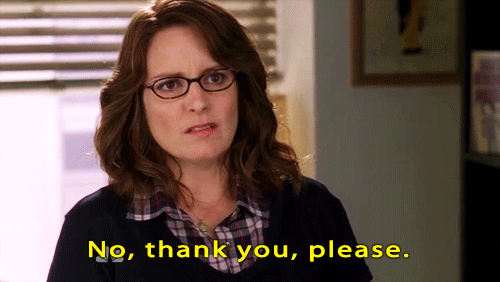
Unless you’re a sociopath, you don’t want to make anyone feel like that.
You don’t want to waste anyone’s time. So, what’s the solution?
Creating a linkable asset.
What Is a Linkable Asset (and Why It Matters for Link Building)?
A linkable asset is a valuable piece of content, like a guide, infographic, or resource, that other websites naturally want to link to. It’s the foundation of any successful link building strategy.
It’s a piece of content on your site that’s worth linking to. Just as most people don’t share photos of their garbage or upload videos of paint drying to YouTube, most webmasters aren’t interested in linking to blank space or junk.
And for the most part, they also aren’t interested in linking to your product or service pages, or pages where you’re telling the world how awesome you are.
Basically, a linkable asset is any part of a website or organization that its target audience will genuinely perceive as worth citing/referencing to. It could be people, content, events or anything that can be really interesting to a specifically targeted market.
Linkable assets accomplish the following:
- They keep attracting links to your website
- They strengthen your expertise, authority and brand presence
- They generate an audience, leads and brand advocates
- They increase your search engine visibility, social media visibility and website traffic
You’re already providing a great product or service and you’re ready to grow your business. You want more leads, and you want to get them directly through your website. That requires traffic, which in turn requires search engine visibility.
Search engine visibility requires healthy, relevant links, and you can’t get those links if you don’t have anything to link to.
You can reach out to other webmasters until your fingers grind your keyboard into a fine layer of plastic powder, but no one’s going to link to you unless your site offers something valuable to your audience beyond your product or service.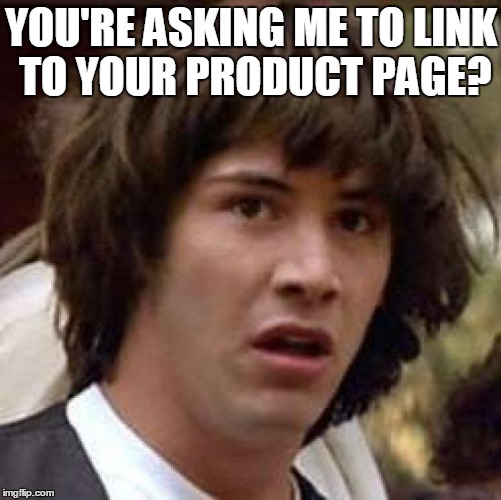
How Can I Create Linkable Assets?
If you’re just starting out and your resources are limited, you could start with something relatively simple.
Consider your audience and your customers to discover:
- What are their common questions?
- What problems can you solve for them?
- How can you make them into better versions of themselves?
- What advice can you offer them?
As Eric Ward put it, “useful content gets linked” and “the less useful your content is, the less likely you are to ever receive a link to it”.
Usefulness can include content that is helpful, educational or entertaining. A linkable asset should never be overly self-promotional, which is a common mistake many people make.
- If you own a record shop or other retail outlet, you could put together a ‘diary series’ chronicling funny, strange and absurd experiences you’ve had with your customers. People love stories. This would fall under the ‘entertainment’ category. If it’s memorable and it makes people laugh, they’ll link to it.
- If you run an automotive repair shop, you could put together a series of short videos about common problems you see all the time. The kind of stuff your potential customers might be inclined to fix themselves. Those videos would fall under the ‘helpful’ category, and people would gladly link to it. It would also establish you as a generous person and an expert.
- If you run a veterinary clinic, you could interview a wildlife biologist, zookeeper or a TV personality from Animal Planet. That’s interesting content, and it also falls into the ‘educational’ category. People love interviews, and they love hearing from people with fascinating jobs. People share and link to content that makes them think and teaches them something.
It doesn’t matter what industry you’re in. Start small and create something cool.
Before we dive into detailed examples, here are 10 types of linkable assets that consistently attract backlinks.
10 Linkable Asset Ideas to Spark Inspiration
-
Beginner’s guides – step-by-step content that helps total newbies get started
-
Original research – unique data, surveys, or findings from your industry
-
Checklists or templates – downloadable tools that simplify a process
-
Expert roundups – quotes or insights from multiple industry pros
-
Tools or calculators – interactive content people come back to and share
-
Curated resources – hand-picked lists of helpful tools, sites, or links
-
Visual timelines or infographics – easy-to-share graphics that tell a story
-
Comparison or myth-busting posts – help readers make decisions or rethink assumptions
-
Ranked lists by location or topic – e.g. best SEO tools, top NYC restaurants
-
Educational video series – short, helpful videos that teach a concept
5 Examples of Linkable Assets You Can Create Today
Example 1: Beginners Guide
Let’s begin with a popular form of content—the Beginners Guide.
These guides help total beginners get started on any given project. It could be baking sourdough bread, sewing, macro photography, blogging, basket weaving, or playing keno.
If you try to out-skyscraper any one of these guides in a saturated niche, you’re going to be disappointed with the amount of links you get.
Still, Beginners Guides are worth taking a look at because they can provide us with inspiration and encourage us to try in a different direction.
I recommend taking a look at a guide not directly related to your niche.
Let’s check out Maurizio Leo’s Beginner’s Sourdough Bread guide, which is as far away from intimidating baking jargon as you can get. And if you’re as crazy about sourdough as my wife is, you’ll love this example even more 😉
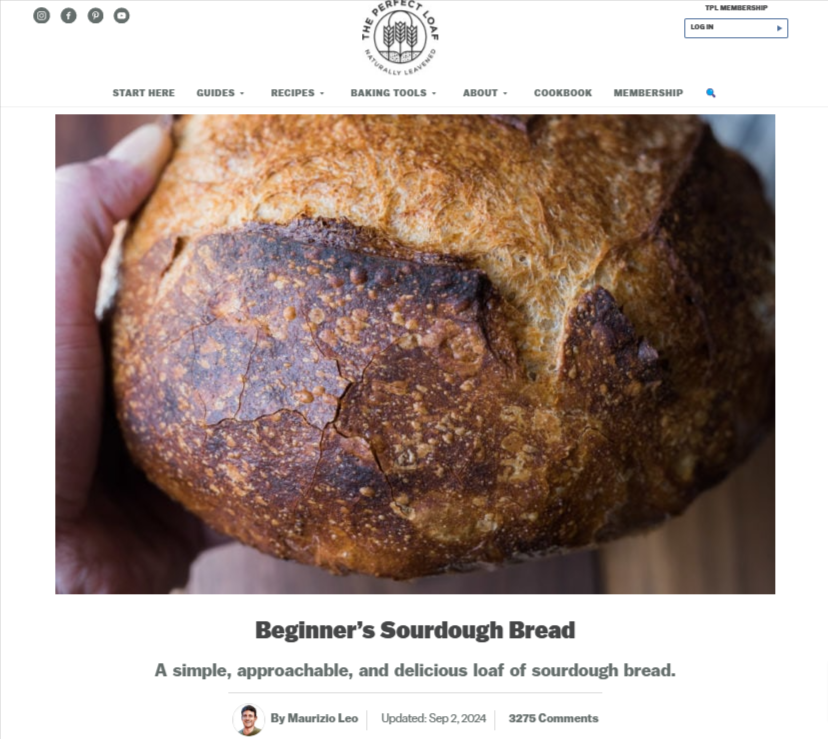
But I love this guide. Maurizio does a great job with his friendly approach, to be sure. He lets you feel like he’s letting you in on the secret to making a simple, approachable, and delicious loaf of sourdough bread. He makes you feel like he’s going to help you every step of the way—and he just might. I haven’t tried every technique myself, but I do know this is a fantastic guide.
Breaking It Down: If you’re diving into this guide, you probably have little experience with sourdough baking, but you’re eager to learn.
Maurizio Leo knows the secret to a good Beginners Guide—making your audience feel at ease. With any Beginners Guide, you’re venturing into uncharted territory, trying to learn something complex well enough to do it on your own.
This guide is comprehensive, broken down into easily digestible steps. It’s well designed and it’s not hard to understand, even for a subject as intricate as sourdough bread.
But what sets it apart is that you get a full guided tour of the sourdough bread-making process. Through this Beginners Guide, you get to know Maurizio, and he personally walks you through everything—from creating a sourdough starter to shaping and baking your first loaf. It’s engaging, friendly, and far from dry or stuffy.
In fact, it’s downright linkable.
You don’t feel like you’re navigating a leaky boat in uncharted waters with this guide. You feel like you’re in good hands.
And that’s why this guide has garnered so many links.
Inspiration: First, look up “(your industry) Beginners Guide” and see what you come up with. Skim through a few of them, and then go back to Maurizio Leo’s guide.
Chances are, the guides you find are impersonal and lack personality compared to his.
What’s something you could realistically, personally help someone accomplish?
If we go back to a home baking blog, maybe that something is baking a perfect sourdough loaf from scratch. The subject matter doesn’t have to be super technical—that’s where you come in.
Write your Beginners Guide like you’re a friendly instructor. Make your readers feel comfortable venturing into something they’ve never tried before. Let them get to know you, and let them trust your guidance.
Share your expertise, even if it’s just about one small part of the process. You can build a linkable asset by taking a personable, easily digestible approach like Maurizio does.
Your job is to hold your reader’s hand through complex, potentially intimidating material. Make them feel comfortable and confident, and you’ll create a stellar linkable asset.
Keep it simple, not stuffy.
Other Examples:
Example 2: Digital PR Content
Have a look at “Best Side Hustles” brought to you by Simply Business—a dynamic example of how digital PR can transform a side hustle study into a powerful, linkable asset.

This campaign isn’t just about listing ways to earn extra money. It digs deep into intersection data and real-world stats, revealing trends that drive the modern gig economy. While side hustle guides may seem narrowly focused, the research behind them exposes fascinating insights into consumer behavior, startup costs, and market potential.
To round off this digital PR effort, Simply Business paired its data-rich study with a comprehensive written guide. The article breaks down the methodology behind the numbers, explaining how each side hustle was evaluated and why certain trends matter. This extra layer of context not only enriches the content but also makes it a valuable resource—one that naturally attracts high-quality links and media mentions.
You could realistically create a digital PR campaign like this, too. Even if you need to collaborate with a data analyst or a designer for eye-catching visuals, the overall investment won’t be overwhelming if you plan smartly. By combining robust data with clear, engaging commentary, you boost the chance of earning organic links and media coverage, far beyond what a standard blog post might achieve.
Breaking It Down:
This digital PR campaign works because it leverages intersection data to tell a layered story. It dissects multiple factors—like initial investment, potential earnings, and market growth—for a variety of side hustles such as freelance gigs, food trucks, and online tutoring. Each statistic is carefully chosen to illuminate a piece of the broader narrative, showing how different elements converge to fuel the side hustle boom. Interactive charts and infographics take complex data and present it in a visually appealing, easily digestible format.
The accompanying article explains the research process in clear terms. It walks readers through how the data was gathered, why certain metrics were used, and what these numbers mean for someone considering a side hustle. This dual approach of combining visual data with detailed written content makes the asset both informative and highly shareable.
Inspiration:
The “Best Side Hustles” digital PR campaign demonstrates that when you blend rigorous research with creative presentation, your content can stand out from the crowd. Rather than simply listing ideas, it shows the real story behind each side hustle by revealing the trends and figures that drive success. This method not only enriches the user experience but also signals to search engines and media outlets that your content is both authoritative and relevant.
Digital PR isn’t just another marketing tactic—it’s a strategic approach to building your brand’s authority and driving meaningful engagement. By integrating solid data with compelling visuals and insightful analysis, you can transform a basic study into a resource that resonates with a broad audience and naturally attracts high-quality links.
With “Best Side Hustles” as your blueprint, you’ll see how a well-executed digital PR campaign can amplify your message, boost your SEO, and ultimately help your brand make a lasting impact.
Other Examples:
How Much Each U.S. State Spends on Education
Most Famous Sandwich in Every State
Top 10 Sunset Locations in the World
Example 3: Resource Page
Now let’s take a look at the venerable Resource Page.
Creating a resource page is actually fairly easy, especially compared to the other linkable assets above.
As humans, when we’re interested in something, we want to consume every bit of knowledge about it that we can. That goes for hobbies, but it also goes for mastering our trades and professions.
We want to know more and get better, and that’s where a good resource page can earn some major links.
Let’s look at McLean’s Guide to Managing Mental Health Around the Holidays.
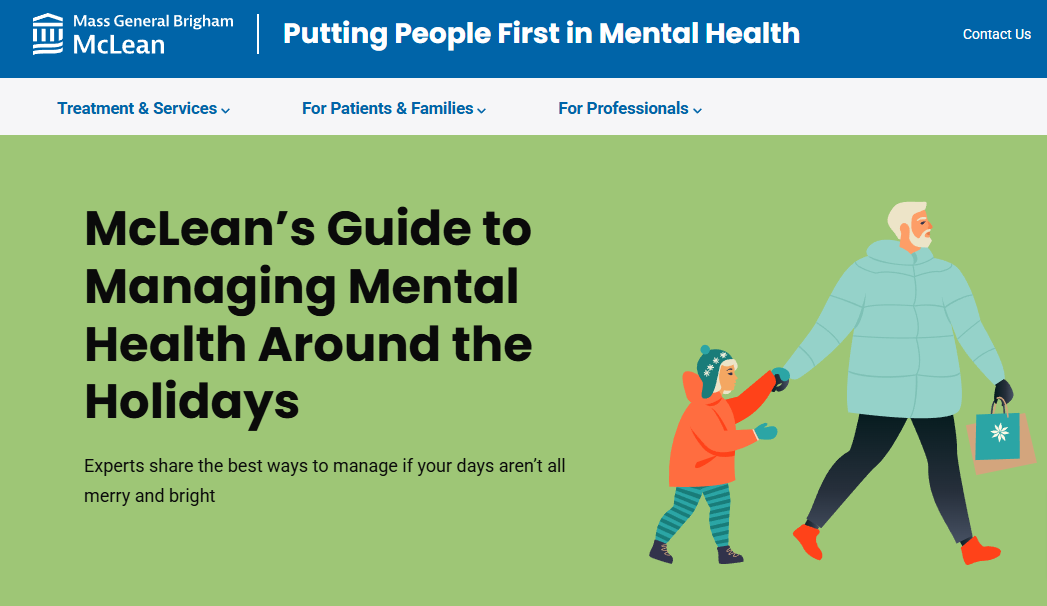
Though it is a guide in many ways, it’s also an excellent resource page.
It contains links to everything you need to know about managing mental health during the holiday season – from dealing with pressure from family and friends, coping with grief and loss, managing holiday stress and low moods, to knowing when to reach out to a mental health professional.
According to Ahrefs, this Guide has about 271 links from unique domains.
It’s more attractive than your average resource page, and it’s also better organized. It’s still a killer resource page where you can find everything you need to know about handling holiday mental health challenges, all in one place.
Breaking it Down: This resource page succeeds because it leaves no stone unturned. It also succeeds because it breaks this huge wealth of information down into bite size chunks.
If there’s something you want to know about managing your mental health around the holidays, it’s probably in here.
A good resource page is thorough, and this one is as thorough as you can get.
Many resource pages are just random collections of links. It seems like someone with a short attention span just adds links whenever it strikes their fancy, and there’s no real end goal.
A thorough, goal-oriented resource page is much more formidable than a haphazard, amateur resource page.
Inspiration: Consider thinking outside the holiday box to spark fresh ideas. For example, a health and wellness site might create a resource page focused on winter self-care strategies. This page could feature expert interviews on mindfulness, interactive mood trackers, and user-generated tips on building resilience in the colder months.
But always keep your resource page focused and goal-oriented. Identify exactly how it should help your audience, and then you’ll have a linkable asset. This is one scenario where you probably can outdo your competitors without overextending your resources.
Other Examples:
- Parents of Children with Food Allergies
- National Association of Automobile Museums List
- 21 Amazing Sites With Breathtaking Free Stock Photos
Example 4: Infographic
Now let’s take a look at one of the most common forms of linkable asset– the infographic.
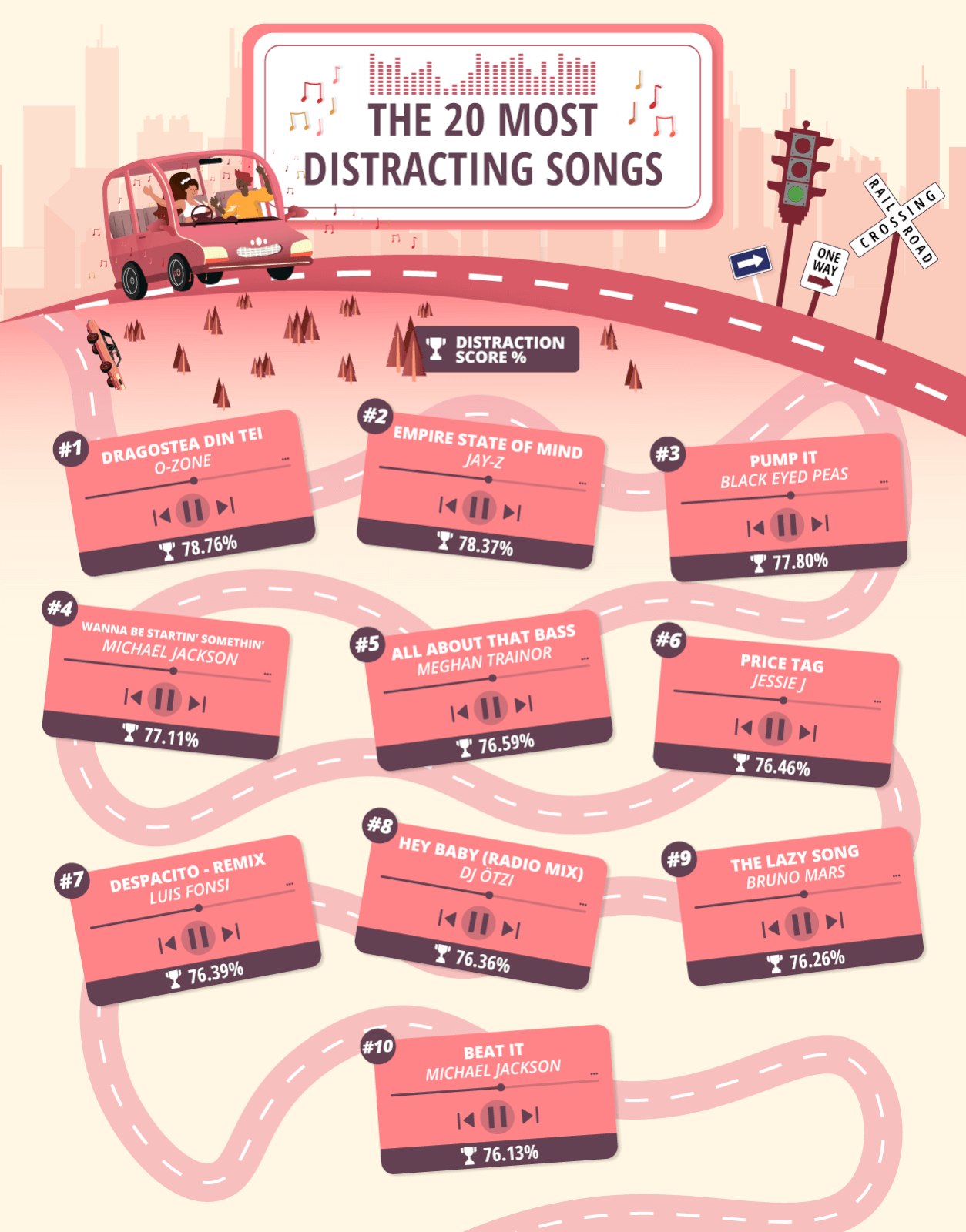
This is a good looking and informative infographic, and the subject matter is good– distracting driving songs might seem like a specific interest, but drivers and music fans are keen to learn how certain tunes could impact focus on the road.
To top off a good infographic, Compare the Market also produced a great piece of written content to accompany it. It expands on the infographic, and I imagine it would be a good starting place for anyone curious about distracted driving.
You could realistically produce an infographic like this, too.
Even if you had to hire a designer, it still wouldn’t be a big resource sink if you did the research. And you could also do a nice writeup like Compare the Market did, which adds extra value to the page itself– you’re more likely to get a text link to the page instead of just an infographic embed.
But it seems pretty obvious to me that Compare the Market didn’t put too much time into link building. According to Ahrefs, this infographic has about 100 links from 6 different domains.
Every link is hyper-relevant, so people appreciate it– they’re just discovering it organically.
Breaking It Down: This infographic is good because it reveals which driving songs are most distracting, and also shows how they were evaluated based on factors like BPM, energy, danceability, and loudness. It’s aesthetically appealing, simple, and easy to read. It’s relevant to drivers, music fans, and safety advocates alike.
They also added real value with the accompanying written content on the page.
Inspiration: So, what can you take away from this?
Obviously, you can see that infographics are still good content. But, you can also dig a little bit deeper.
This website focuses on car insurance and driving safety, which are generally of interest to drivers. But instead of making an infographic solely about insurance or safety tips, they thought a little bit bigger and broader– they made an infographic about the most distracting driving songs. This appeals beyond their core audience, reaching out to both drivers and music enthusiasts.
If they want links, this is a good way to go. They didn’t try to outdo any other driving song infographics. Instead, they put their own spin on it, added some extra value, and created a strong piece of content.
They also link to all of their other related content assets on the infographic page, just to get you more invested. Those are more focused on people who might be researching driving safety or car insurance. So, it works from a digital marketing perspective, and it could work very nicely from a link building perspective.
So, how does this apply to you?
Really, a thematic infographic can work well in any niche.
Let’s say your website focuses on car accessories or auto insurance. You could easily do an infographic that focuses on how popular songs influence driver focus over time. You could keep it simple for the infographic, citing famous tracks and relevant driving statistics. Then, you could create a 750-word piece of content for the infographic page, explaining how these musical factors impact driver safety and even insurance premiums. And, if you wanted to drive with the focus of a pro, you could just head over to a product page featuring safety gadgets.
This goes broader because it will appeal to drivers, music enthusiasts, safety advocates, and those interested in auto insurance. Automotive bloggers, lifestyle bloggers, tech reviewers, and safety experts are all potential link sources.
All potentially good links for a car safety blog, an auto insurance provider, or a local dealership.
Now, do a quick Google search for “(your niche) infographic” and see what you find. Select a good one, and then think about it in the context of this distracting driving songs infographic.
Getting any ideas?
Other examples:
Example 5: Ultimate Guide
Finally, we come to ultimate guides.
Many people think of these as the “be all, end all” of linkable assets.
You also have to know the difference between 101 guides and ultimate guides. A 101 guide is for beginners. An ultimate guide is for people who are already hardcore about any given subject– they just want to do it better than everyone else. They know the basics, and they want to dominate.
Let’s use Android Central’s Pokemon Go: The Ultimate Guide as an example.
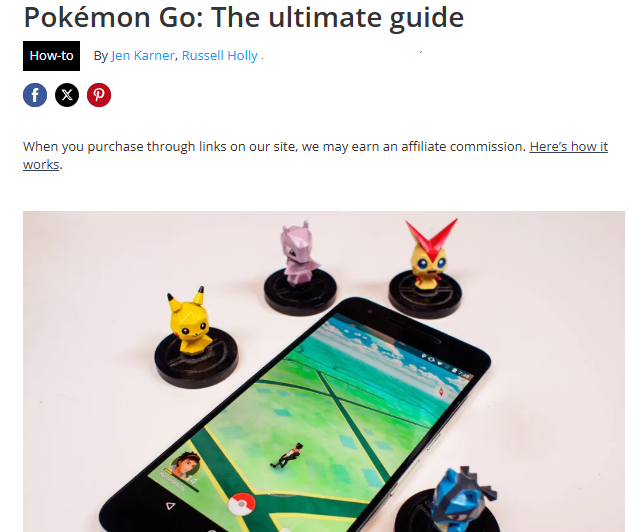
This is how they start the guide:
“If you’re here, it’s because you want to become the best Pokémon trainer that you can be. If you’re just getting started with Pokémon Go, then you should check out our guide to getting started before diving in here. This guide is for those of you who are grinding levels, capturing Pokémon and taking over Gyms.
As you know by now, there is a lot going on with Pokémon Go, and we’re going to detail most of it out for you here.”
They also provide a link, right up front, for parents whose kids are playing the game. They’ve covered all of their bases, and they’ve identified their audience right out of the gate.
Breaking it Down: This guide succeeds from the start because Android Central does something most ultimate guides don’t do, and they do it in the first two paragraphs– they identify who the guide is not for.
This lets the hardcore Pokemon Go players know they’ve found the right bit of content, and it means they’re more likely to share it with their friends.
If you were doing outreach for this guide, it would be a breeze. Seasoned gamers, Pokemon fanatics, mobile gamers, anime fans, and obsessed kids all feel like they’ve struck gold. It could earn links from geek culture blogs, mobile game blogs, anime blogs, Pokemon blogs, general game blogs, and more.
This guide keeps it simple, but it doesn’t pander and it doesn’t waste time. I don’t know much about this game, other than remembering when it was on the news 24/7, but this guide goes at a brisk pace and is full of actual details from people who have succeeded playing Pokemon Go.
It’s long and detailed, but there’s no fluff. It respects the reader’s time, so they can find what they need and get back to the game.
Inspiration: So, how do you find inspiration in this? Making something like this ultimate guide seems pretty overwhelming, right? It does to me.
Instead of getting overwhelmed, do a search for “(your industry) ultimate guide” or “(your hobby) ultimate guide.” Read a few pages, and then ask yourself– what do you wish they’d addressed?
What was missing?
Figure out what the guides in your industry haven’t covered, and then make an ultimate guide that answers those questions.
Identify who the guide is not for. The guide is not for the people who were satisfied with those other guides– it’s for the people who cared enough, who are hardcore enough to have the same questions you did.
Just like the Pokemon Go guide isn’t for beginners, yours shouldn’t be a 101 course. It should dig deeper into the unexplored, and ignore the already-covered territory entirely.
Back to the bedding retailer example– if you dug through several textile guides but found their coverage on certain skin conditions lacking, you could put together an ultimate guide to help people with Rosacea find an ideal pillow, blanket, and sheet combination to fit both their skin condition and sleep style.
Other Examples:
- The Step-by-Step Guide to Creating a Money-Making Blog in 47 Minutes
- Ultimate Guide to Plant-Based Nutrition
- Ultimate Guide to Healing Back Pain
Conclusion
When you’re thinking about creating a linkable asset, know you don’t have to break the bank.
Poke around and see what people in other industries are up to. By investing in quality content over time, you not only attract more links but also build lasting trust with your audience.
The bottom line is that you can’t build links unless you have something valuable to link to, but people try regardless. When you don’t have any linkable assets, you’ll spend hours on outreach and promotion without achieving any results.
If you want other websites to link to you, you have to give them a reason.
Want help figuring out what kind of linkable asset would work best for your site? Let’s chat!
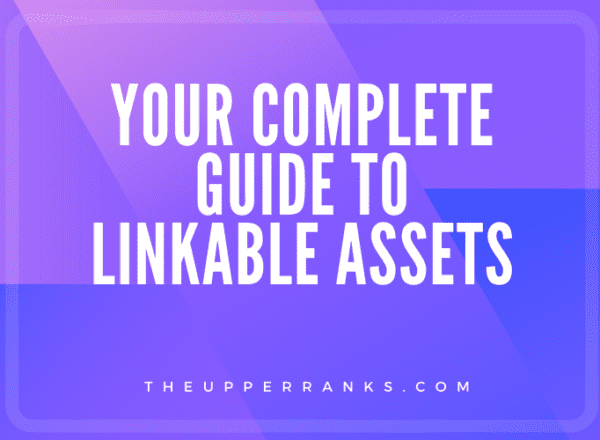
Comments
Great post David. We blog twice a week, but this got me thinking that maybe we should focus more on a really high quality linkable asset instead of posting often.
Thanks Susan, and that sounds like a great plan!
Another great post Dave, so true!
Thanks Jamie 🙂
I did a video showing my plumbing client installing a tankless water heater. Nothing fancy. No sales message. It’s pushing 40,000 views. he’s sold a lot of water heaters because of that video over the past 5 years!
Sounds like a cool video, Bob. One thing that’s important to keep in mind is that views don’t automatically translate into links, and for that you’ll need to have an outreach strategy.
This couldn’t be more true. From someone that runs an online marketing agency in Australia I find that clients are still struggling with the need to produce good content let alone linkable assets.
At some stage in most campaigns it’s likely that some form of offsite or link building will be required and if you have linkable assets it makes it so much easier. I find however that as a third party operating on their behalf you can either a) content mentor or b) content market. If you go option B and do it on their behalf then it’s more challenging to create a linkable asset without the input of the business owner.
Good point Byron, creating something worth linking to isn’t a walk in the park, but there really isn’t any alternative to building quality links.
To those that struggle I recommend starting small and keeping it simple. As an expert in your industry you’ll be surprised how much you can help out others with your knowledge base. You can even just come up with an FAQ page where you list the most common questions you get from your customers and your answers and tips.
Byron – Agreed, getting the content message across is still a tough sell and often met with “can’t you just fix our site so Google ranks it”.
I blog once a week regularly. Consistency blog experts say is a must in order to attract loyal readers and search engines. Once a week posting of an article will give you a lot of time to improve any deficiencies your article will have but link is very hard to come no matter how well you put efforts into your articles.
Sounds like you’ve got something good going, Bigwas!
Sticking to an editorial calendar is great AS LONG as the quality is there.
And links won’t appear magically no matter how good your content is. You’ll need to be pro-active in finding and asking relevant sites to link to you. I wrote about this in detail here http://10.0.0.111/upperrank/site1/ask-for-links-because-you-cant-rank-without-them/
Keep me posted on your progress.
A fantastic post – tweeted, shared on social media.
In my own business, I’m on a crusade to STOP what I’ve termed “mindless blogging” because I know there’s better way to get qualified increased traffic to websites and a better use of people’s time.
And I prefer to free people of their editorial calendar because I think that’s been the problem – people think they need to blog regularly when it can do more harm than good.
The most valuable links and shares will be earned due to deserving content. The problem is most people don’t create “deserving content.” So much stuff is regurgitated and filler content.
In this era of masses of content and competition, I believe for entrepreneurs and business owners to stand out from the crowd, they MUST produce outstanding, exceptional content. No exceptions.
Glad you enjoyed Shae, and thanks for sharing!
Great comment and I couldn’t agree more, that it’s more about the quality then the quantity. It seems like a lot of people get caught up in this craze to churn out mediocre content just for the sake of creating content or satisfying search engines or some other reason. I look forward to hearing from you again 🙂
I never thought an article on ‘link building’ could be interesting, but you proved me wrong, Nicholas! #HUGSS
LOL, thanks buddy 🙂
Nice post David, and you make good points. The fist thing I’d suggest doing before considering writing a blog post is, ask yourself, would YOU be interested in the post you’re about to write if you found it?! If the answer’s ..erm.. nah not really, don’t write it.
Thanks for the tip Chris!
Hi David,
Great article and I love to reading some of the comments as well. I think a lot of people get advised to “start blogging” as a way to great content but invest a lot of time and effort in content that never makes it to the top of the rankings.
In my opinion the lack of good keyword research, knowledge of search intents and the lack of understanding the value of linkable content are the main reasons people keep on investing in this type of content. Besides that a lot of people think they keep their website “fresh” this way, although those ranking signals only apply to an certain type of search intentions.
After reading the article I was wondering, do you link from your linkable assests to the sales pages / the pages with a buying intention as an way to deliver more linkjuice to them? At this moment I do add those links if they seem appropriate, but they always give me the feeling they make my linkable assest less linkable. What’s your point of view on this?
Best regards,
Bob
Bob, It’s essential to keep linkable assets non-promotional.
I suppose if you’re able to naturally link to a product without it appearing as an ad, that should be fine.
I’ve been talking about “linkable assets” a lot lately. So glad to see someone sharing the same sentiments.
John – Glad we’re on the same page 🙂
This article is exactly what I tell clients on a daily basis. I work with local based clients usually in the service industry, so a lot of the industries could be considered ‘boring’ or ‘difficult’ to create content for.
Informative, how-to content is always great and with a little thought, effort and creativeness, you can always come up with ideas that will work for your business.
Absolutely Liam!
This is absolutely amazing post and very help full to buld linkable assets
I appreciate the kind words, Zemen!
This article does a great job at articulating the importance of a linkable asset. Well done David.
Glad you enjoyed it, Carmelo.
Wow, this post is excellent and I really love reading your articles.
A lot of people are searching for this type of content and you can aid them greatly. Keep up the good work!
Thank you for your vote of confidence!
Precisely! Once in a blue moon, I get an email asking me to link to somebody’s website. Then I look at the website and can only wonder, “Why?” There’s nothing of value for my users, so why would I do that? How does wasting my people’s time increase my credibility?
This degree of honesty is what’s killing my own efforts at link building before they start. I’ve got a Resources page, and I happen to think they’re brilliant resources. I wrote them all, so I’m probably biased, but still…
I know that lack of incoming links are the single greatest weakness in my website. This blog post encapsulates why it’ll probably stay that way. Thanks for writing it!
Glad you like it and found it helpful, Michael! Best of luck with your link building efforts!
David! Thanks for your nice post. I think Infographics is the best way to get more and more Quality Backlinks.
Thanks, Anwarual and I totally agree that infographics, when done right, can make for awesome linkable assets!
Imagine if businesses took to building linkable assets like they took to buying links back in the day… WOW! We’d have a lot of great content out there versus a sea of spam.
Haha, you’re absolutely right about that, Ryan! Apparently, the lure for short-cuts and tricks is more tempting than just doing things the right way =)
Thank you for sharing this David and looking forward to building high-quality links to my website 🙂
Best of luck, Austin!
Hey David,
Love the way this article is structured and enjoy the examples of linkable assets you have.
Feedback means a lot, Dru, and glad you enjoyed it!
Good job David! Awesome tips here.
Thanks so much for stopping in, Emmerey!
Appreciate the article David. Curious if you have any suggestions for good infographic designers that can be used as linkable assets? Either DIY sites or agencies.
Not off the top of my head, Gary – sorry about that!
You definitely put a brand new spin on a
subject which has been discussed for years.
Great insights! I completely agree that having strong linkable assets is crucial for effective link building. It’s not just about acquiring links but creating content that genuinely adds value and attract attention. I’d love to hear more examples of linkable assets that have worked well for others!
Great insights on linkable assets! I especially appreciated the examples you provided on different types of content that can attract backlinks. It has really motivated me to rethink my content strategy and focus on creating more valuable resources. Thank you for the practical tips!
Great insights on linkable assets! I loved the practical tips on creating valuable content that truly resonates with audiences. The examples provided really helped clarify the concept. Looking forward to implementing these strategies in my own content creation!
Great insights on linkable assets! I especially appreciated the tips on creating infographics and comprehensive guides. It’s clear that investing time and resources into high-quality content can lead to valuable backlinks. Can’t wait to try out some of these strategies for my own website!
This post really clarifies the concept of linkable assets! I love the practical tips you provided for creating content that stands out and attracts links. The examples were super helpful in visualizing how to implement these strategies. Looking forward to trying some of these ideas for my own blog!
Thank you so much, glad you enjoyed and best of luck on your own blog!